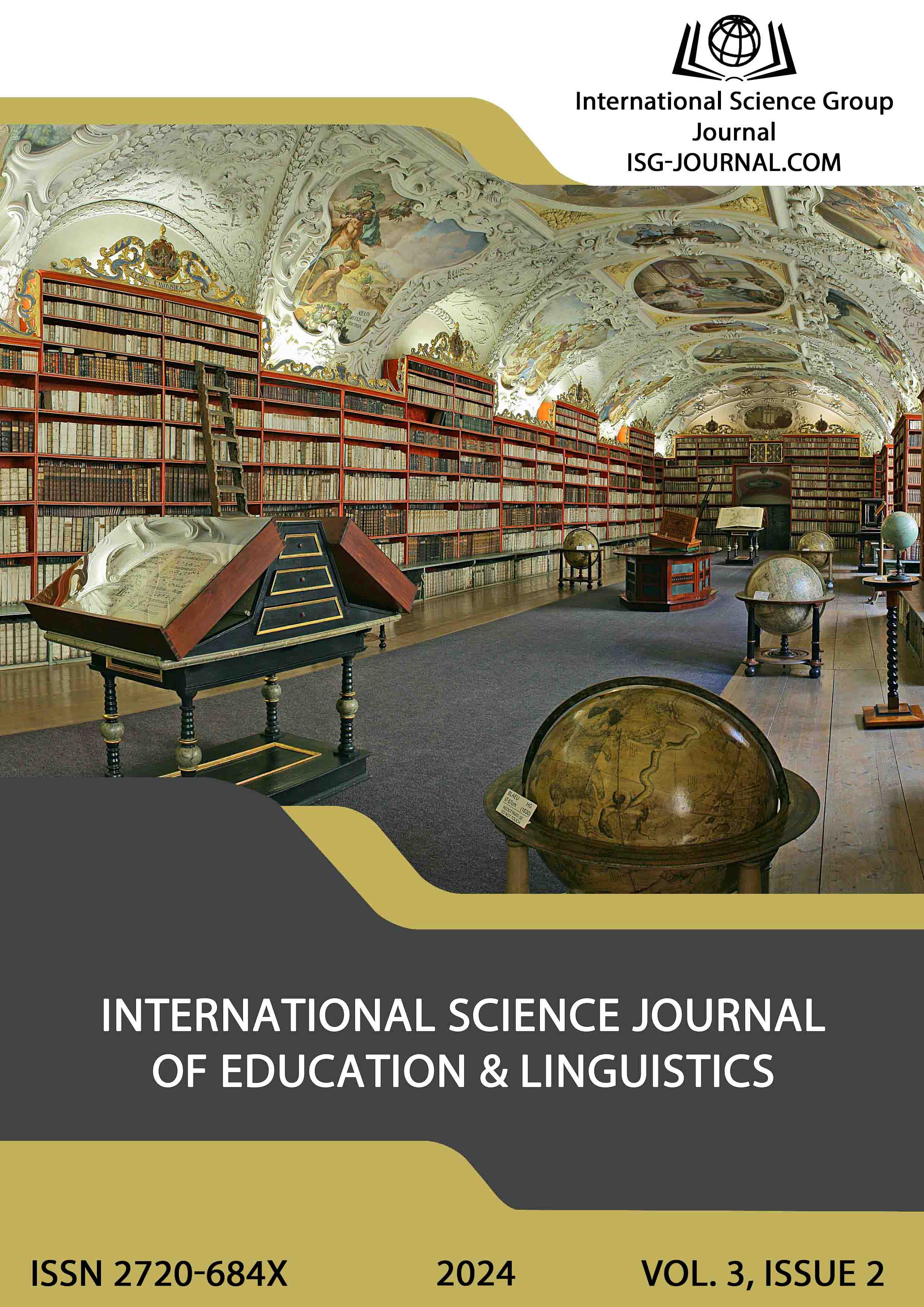The role of the language environment in foreign language classes
DOI:
https://doi.org/10.46299/j.isjel.20240302.08Keywords:
communicative competence, foreign language, immersive environment, language environment, teaching method, teaching strategyAbstract
Creating and implementing a favorable language environment in foreign language classes is an important tool for effective language teaching to students and improving their language competence. The language environment is a complex, and dynamic concept that includes the physical environment, its participants, cultural context and social norms that regulate language use. The language environment has a significant impact on a person's linguistic, cognitive, and cultural development. The use of authentic materials, interactive teaching methods, modern technologies, and immersive methods of foreign language learning contribute to the development of professional competencies of future specialists. It is important to take into account socio-cultural elements such as literature, films and music to create a language environment that facilitates the acquisition of language skills and the development of general foreign language competence. The successful implementation of the strategy of creating a foreign language environment has been greatly facilitated by the integration of modern technologies that provide access to a wealth of information and resources. Interactive methods such as group work and pair work can create a collaborative learning environment that encourages learners to engage in meaningful communication. Teachers can use strategies such as SWOT analysis and project work to evaluate the effectiveness of their teaching methods and develop targeted strategies to identify strengths, weaknesses, opportunities, and threats to further learning of specific topics or the target language in general. The language environment plays a crucial role in assessing students' language proficiency, as it provides opportunities to practice the target language communication, followed by teacher feedback. A dynamic language environment reflects the realities of today and contributes to the comprehensive development of competent professionals.References
Lin W. (2011) Comminicative strategies in second language acquisition. Kristianstad University.
Oxford R. (2016). Teaching and researching language learning strategies: Self-regulation in context. Taylor & Francis.
Krashen S .D. (1982) Principles and practice in second language acquisition. Oxford: Pergamon Press.
Ellis R. (1999) The study of second language acquisition. Shanghai: Shanghai Foreign Languages Education Press.
Taron E. (1980) Communication Strategies, Foreigner talk and repair in interlanguage? Language learning, 30, 417–413.
Dörnyei Z., Muir C. (2019). Creating a Motivating Classroom Environment. Second Handbook of English Language Teaching. Springer International Handbooks of Education, 719–736.
Rao P. S. (2019). The importance of speaking skills in English classrooms. Alford Council of International English & Literature Journal (ACIELJ), 2(2), 6–18.
Кравець Л.В. Мовна особистість сучасного українського науково-педагогічного простору. Available at: https://enpuir.npu.edu.ua/bitstream/handle/123456789/6953/Kravec.pdf?sequence=1&isAllowed=y
Баланюк В.С. (2014) Мовне середовище та мовна особистість: соціокультурні фактори підготовки майбутнього вчителя. Педагогічні науки, 116, 10–17.
Наконечна Л. Б. Мовне середовище як проблема наукового дослідження у контексті підготовки майбутніх учителів до професійної діяльності. Науковий вісник Ужгородського університету. Серія: «Педагогіка. Соціальна робота», 2021, № 1(48), 289–292.
Мовне занурення: імерсивний метод вивчення англійської. Available at: https://www.management.com.ua/partners/2023/08/28/movne-zanurennya-imersivnij-metod-vivchennya-anglijskoyi/
Димова І. (2022) Імерсивний підхід в системі університетської освіти. Актуальнi питання гуманiтарних наук, 48 (1), 289–293.
Голіяд І. С., Тропіна М. А. (2021) Імерсивні технології у графічній підготовці майбутнього вчителя. Імерсивні технології в освіті: збірник матеріалів І Науково- практичної конференції з міжнародною участю, 65–67.
актуальних тенденцій викладання англійської мови. Available at: https://znayshov.com/News/Details/5_aktualnykh_tendentsii_vykladannia_anhliiskoi_movy
Коротка, Н. В. (2018) Роль автентичних матерiалiв в вивченнi дiлової англійської мови. Наукові записки Національного університету «Острозька академія». Серія : Філологія, 4 (72), 124–127.
Будас Ю.О. (2018) Вплив зворотного звʼязку на формування іншомовної професійної компетентності. Сучасні інформаційні технології та інноваційні методики навчання в підготовці фахівців: методологія, теорія, досвід, проблеми, 2018, 51, 202–206.
Naidionova A. V., Ponomarenko O. G. (2018) Use of podcasting technology to develop students’ listening skills. ITLT, 63(1), 177–185.
Галай Т., Озарко Т. Використання інтернету при вивченні англійської мови у ВНЗ. Наукові записки. Серія: Педагогіка, 2008, 7, 46–49.
Ушакова І. О. (2018) Розвиток міжкультурної комунікації на заняттях з англійської мови за професійним спрямуванням. Духовність особистості: методологія, теорія і практика, 3(84), 254–265.
Оголь А. SWOT-аналіз із прикладами. Available at: https://esputnik.com/uk/blog/swot-analiz-iz-prikladami
Downloads
Published
How to Cite
Issue
Section
License
Copyright (c) 2024 Olena Yazlovytska

This work is licensed under a Creative Commons Attribution 4.0 International License.





